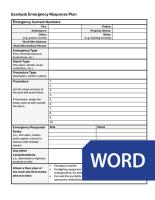Site-specific emergency response planning is vital to ensure every person in the workplace understands what they must do in case of an emergency.
In general, everyone at your workplace must know:
- How to contact local emergency services: fire department, RCMP, ambulance.
- What steps to take in an emergency, including who sounds the alarm, designated evacuation routes, and where muster points are located.
- Where the emergency equipment is located and who is trained to use it.
- How to report emergencies and who to report to.
FIRE SAFETY PLAN: Every worksite must have and post a fire safety plan. This informs every person in the workplace what they must do in case of an emergency, including:
- The emergency procedures everyone must follow in case of a fire, and how to;
- Sound the fire alarm,
- Notify the fire department, and
- Evacuate, including any special provisions for workers with disabilities.
- The quantities, locations and storage methods of flammable substances present at the work site.
- How to control fire hazards.
Employers must hold a fire drill at least once each year and have a record of the date and time it occurred.
Required Documentation
- Over 20 Employees:
- A written, posted Emergency Response Plan that includes a fire safety plan and procedures.
- A written, posted Emergency Response Plan that includes a fire safety plan and procedures.
- Under 20 Employees:
- A written fire safety plan that includes:
- An evacuation plan with muster points.
- A list of flammable substances at the work site.
- Records of fire drills.
- A list of workers who may need special assistance when evacuating.
- A written fire safety plan that includes:
Regulatory Reference
- OHS Regulations: Section 394

